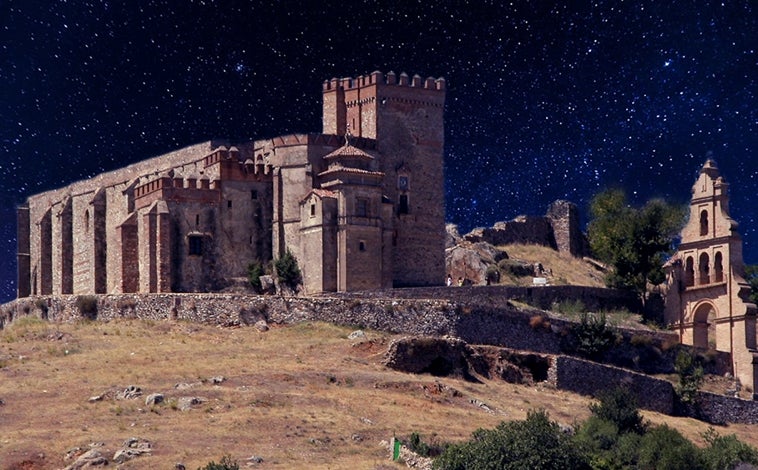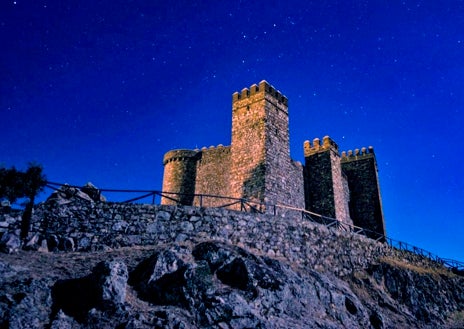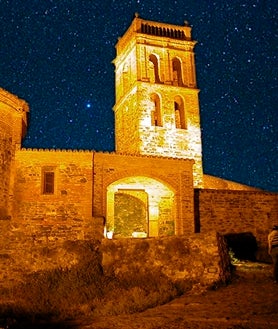Huelva under the stars: discover the best astronomical viewpoints in the Sierra de Aracena

With the arrival of summer and the warmer weather, astronomy enthusiasts begin to seek out unique spots where they can enjoy the vastness of the celestial vault at night. The province of Huelva boasts the highest percentage of clear, dark skies in Andalusia, particularly in the coastal regions of Doñana, Andévalo, and the Sierra de Aracena and Picos de Aroche.
Thus, the northern part of the province of Huelva, due to the low light pollution of its night skies, was declared a Starlight Reserve and Tourist Destination in 2014. This is a guarantee of quality recognized by UNESCO for observing the celestial vault, as 60% of the nights are clear and the darkness of the sky is similar to or greater than that of many professional observatories internationally.
Within the mountainous region, the municipality of Higuera de la Sierra is one of the most interesting destinations for astrotourism enthusiasts due to its lack of light pollution. Here, the City Council has marked a 2.8 km circular trail through the Sierra de Santa Bárbara, offering beautiful panoramic views and a privileged vantage point for observing the sky on clear, clear nights.
The observation point, located next to an unfinished chapel known as the Monument, on which an Infoca station has been built for detecting forest fires, has an explanatory table about the celestial vault, along with reclining benches. The trail can be accessed from the village via the Calleja del Infierno (Hell's Alley) or via the Camino de la Umbría (Shady Path). Coordinates: 37.845423°N -6.445492°W.
Among the natural attractions in Corteconcepción, we recommend climbing Cerro de la Crucecita, 300 meters from the town center, from where you can enjoy unbeatable views of both the reservoir and the surrounding mountains, as well as the municipality. The viewpoint is located within a recreational area, which includes a playground, picnic area, parking, and a world map with reclining benches for educational stargazing.
The climb to the viewpoint from the recreational area, although on foot, can be done safely thanks to the safety fence with fluorescent markings that mark the path. The Cortesano Hill offers one of the best spots for stargazing, with a 360-degree panoramic view and a very dark sky, especially on its northern slope, over the Aracena reservoir. Coordinates: 37.902535ºN-6.504779ºW.
The 13th-century Castle Hill, from which the entire town of Aracena and much of the Sierra can be seen, is another ideal place to contemplate the celestial sky. Public facilities have been installed at the site, such as astronomical panels for stargazing, due to the extreme darkness of the night sky and its mountainous terrain, which make this place an exceptional window into the celestial vault.
From the top of the hill overlooking the town, at an altitude of over 750 metres, there is a sweeping view of the mountain range, towards Seville, and the Huelva regions of the Cuenca Minera, Condado, and the Huelva coast. There is also an extraordinary bird's-eye view of Aracena, with its "peculiar layout and unique buildings." Access coordinates to the Castle: 37.532331ºN - 6.334528ºW.



Nestled in a deep valley facing south, the stargazing lookout is located at the highest point of the village. The observatory, which offers excellent views of the Earth's ecliptic or the zodiacal path, has a paved platform or balcony surrounded by a fence, ideal for small group activities of up to 20 people.
To access this astronomical observatory, you must first visit the Botanical Garden, located on Avenida de Andalucía. The garden has a metal gate that leads to a small slope that connects to the viewpoint. Simply follow the signs. The access coordinates are 37.881633°N-6.621657°W.
Within the municipality of Alájar, the Peña de Arias Montano is one of the most significant and visited sites in the Sierra de Aracena. A natural balcony overlooking the Alájar Valley, it overlooks the south, offering impressive panoramic views that allow for a good portion of the southern portion of the celestial vault, constituting one of the most privileged astronomical views in the province.
This magnificent enclave, where the Virgin of the Queen of the Angels is worshipped, was the residence of an illustrious 16th-century humanist, Benito Arias Montano, advisor to King Philip II. To get there from Alájar, take the HU-8121 road towards Fuenteheridos. The access to the site and its parking lot are located two kilometers away. Coordinates: 37.877122°N - 6.668244°W.
Located a few kilometers south of Alájar, on a rise in the Llanos de Orullos, is the Hermitage of San Bartolomé. Above this chapel is an astronomical observation platform equipped for the use of three simultaneous telescopes with access to electricity. The site also offers privileged views for stargazing, enjoying a space free from light pollution.
To reach the San Bartolomé viewpoint, hikers must leave Alájar in the direction of Santa Ana la Real on the HU-8105 road. Take the first turning on the left past the village of El Collado. After that, continue along a paved road for about seven kilometers until you reach the hermitage. It should be noted that this is easily accessible for vehicles. Coordinates: 37.830917°N -6.643453°W.
In Santa Ana la Real, there is a 2.5-km themed circular trail that aims to introduce visitors to astronomy and provide basic knowledge about observing the night sky. Along the route, there are three interpretive panels with text and images explaining concepts about the universe, accompanied by QR codes that allow visitors to download additional information in the form of an audio guide.
At the highest point, there is a granite table marked with the cardinal points, ideal for telescope viewing. To reach the viewing point, you must first reach the town of Santa Ana la Real and exit via Martín Vázquez Street to a concrete path where the trailhead sign is located. The access coordinates are: 37.861741°N -6.723148°W.
One of the peaks with its own distinctive character, as well as one of the highest peaks in the province, is Cerro San Cristóbal, at an altitude of 912 meters, in Almonaster la Real. At the summit, there are two ideal astronomical observation points: one facing south and the other facing north. During the day, it offers magnificent panoramic views from which to see the town's mosque and dozens of kilometers of surrounding land.
The path up to Cerro de San Cristóbal, which has significant slopes, starts in the town of Almonaster la Real, where you take the HU-8105 road and turn off a few meters from the town onto a paved track on the left, with a steep upward slope until you reach the viewpoints. Coordinates: 37.885141°N - 6.777690°W.
On the way up to Cortegana Castle (13th century) and before reaching the Visitor Reception Center, there's an ideal spot for skywatching. It's a small natural platform, an old threshing floor that has been converted into an astronomical viewing platform. It faces east, with the light pollution of the village behind it, offering visibility of the dark sky from north to south.
The area is being redesigned to expand the parking lot, and the observatory will be completed with an information table, safety guards to prevent falls, and possibly a reclining bench for stargazing. The municipality organizes astrotourism activities in the summer, such as "Starry Night at the Castle," with a guided tour, sunset viewing of the cosmos. Coordinates: 37.910779ºN, -6.814983ºW
Near Rosal de la Frontera, next to the N-433 national highway, Seville-Lisbon, at km 155, there is a megalithic structure consisting of six large orthostats arranged in a circular shape. The first archaeological excavations suggested a corridor dolmen, but recent research suggests it may have been a solar calendar in the form of a cromlech similar to the one at Trigueros.
Its connection with astronomy is highlighted by one of the large stones in the complex, which features the seven main stars of the Ursa Major constellation carved into it. The cromlech is located on a plain along the banks of the Chanza River, allowing for high-quality astronomical observation on clear, sunny nights. Coordinates: 37.977445°N-7.143422°W.
From these privileged vantage points, astronomical phenomena such as meteor showers can be seen in the summer. One example is the Delta Aquariids, which, although visible from July 12 to August 23, do not reach their peak until the end of the month. Also in August (the 2nd), it is Saturn's turn to reach opposition, when the Earth places itself between the ringed planet and the Sun.
But, without a doubt, the most anticipated meteor shower of the year for both experts and the general public is the Perseids, a phenomenon that originates near the constellation of Perseus. During this astronomical spectacle, which reaches its peak on August 12 and 13, coinciding with the feast of Saint Lawrence, up to 60 meteors can be observed per hour. Quite an event from the summit.
Likewise, other phenomena can be observed within the summer program, such as the planetary conjunction of Mercury and Mars on August 19; the opposition of Jupiter on the 20th; and the Blue Moon phenomenon on the 22nd. In September, Mercury can be observed at its maximum eastern elongation (on the 13th) and the Harvest Moon (on the 20th), coinciding with the end of summer.
ABC.es





